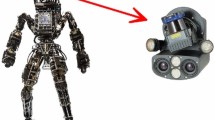Abstract
When a multi-legged animal walks over uneven surfaces, each leg has to span a different distance between body and ground. Thus the animal has to solve the problem of how to control the body height, i.e. to coordinate the movement of the legs in such a way that the vertical projections of leg lengths match these distances. For the standing animal, this is investigated here by testing twelve different substrate configurations and measuring body height and forces applied by the legs on the substrate. The results are consistent with the hypothesis that the legs can be considered to represent independent height controllers. They can be understood as proportional controllers with nonlinear characteristics. The mechanical coupling between the leg is sufficient to explain the experimental results. Thus, no neuronal coupling has to be assumed to exist between these controllers. This agrees with a hypothesis proposed earlier for walking animals (Cruse 1976).
Similar content being viewed by others
References
Bässler U (1965) Proprioreceptoren am Subcoxal- und Femur- Tibia-Gelenk der Stabheuschrecke und ihre Rolle bei der Wahrnehmung der Schwerkraftrichtung. Kybernetik 2:168–193
Bässler U (1977) Sensory control of leg movement in the stick insect Carausius morosus. Biol Cybern 25:61–72
Bässler U (1983) Neural basis of elementary behavior in stick insects. Springer, Berlin Heidelberg New York
Cruse H (1976) The control of the body position in the stick insect (Carausius morosus), when walking over uneven surfaces. Biol Cybern 24:25–33
Cruse H, Saxler G (1980) Oscillations of force in the standing legs of a walking insect (Carausius morosus). Biol Cybern 36:159–163
Cruse H, Schmitz J (1983) The control system of the femur-tibia joint in the standing leg of a walking stick insect Carausius morosus. J Exp Biol 102:175–185
Graham D (1985) Pattern and control of walking in insects. Adv Insect Physiol 18:31–140
Kemmerling S, Varju D (1981) Regulation of the body-substrate-distance in the stick insect: responses to sinusoidal stimulation. Biol Cybern 39:129–137
Kemmerling S, Varju D (1982) Regulation of the body-substrate-distance in the stick insect: step responses and modelling the control system. Biol Cybern 44:59–66
Wendler G (1964) Laufen und Stehen der Stabheuschrecke: Sinnesborsten in den Beingelenken als Glieder von Regel-kreisen. Z Vergl Physiol 48:198–250
Author information
Authors and Affiliations
Rights and permissions
About this article
Cite this article
Cruse, H., Riemenschneider, D. & Stammer, W. Control of body position of a stick insect standing on uneven surfaces. Biol. Cybern. 61, 71–77 (1989). https://doi.org/10.1007/BF00204761
Received:
Accepted:
Issue Date:
DOI: https://doi.org/10.1007/BF00204761




